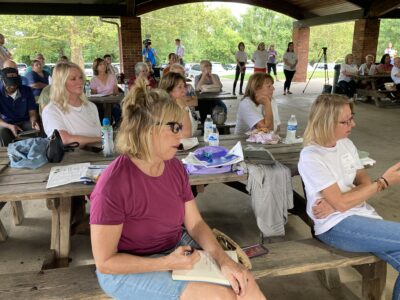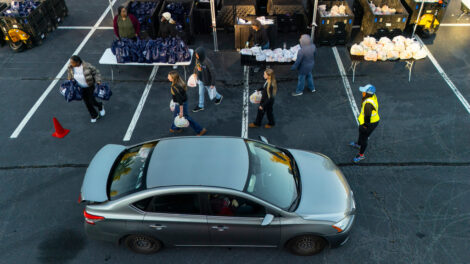New Group in Wheeling Aims To Shed Light on Human Trafficking

photo by: Joselyn King
Members of the community attend a gathering organized by the the Ignite Hope group Thursday night at the Sonneborn Shelter at Wheeling Park. Speakers addressed the issue of human trafficking.
WHEELING — Human trafficking is among the fastest growing crimes in society, and a $150 billion annual industry. And a lot of times the victims don’t even know that it is happening to them, according to local experts.
A new Wheeling group calling themselves “Ignite Hope” came together to learn more about the issue Thursday night. They invited the public and a series of speakers to attend the event, which took place at the Sonneborn Shelter at Wheeling Park.
The first to speak was Heather Lapp, chief strategic officer for YMCA Wheeling. She explained human trafficking isn’t always about forcing someone to engage in sexual acts against their will, and that it’s more about the exploitation of one person by another for personal gain.
“It can be subtle, overt, physical or often psychological,” Lapp said. “And any exploitation of a minor under the age of 18 engaged in commercial sex acts is always considered a form of trafficking.”
There are actually more people being labor trafficked, but sexual trafficking is more profitable to traffickers, she continued.
“On average, it costs $90 a day to buy a person,” Lapp said. “We are definitely in modern day slavery where humans are a commodity.
“Back in 1850, the cost of a slave in today’s dollars was about $35,000. Today it is $90.”
The reason humans are a big commodity is that “they can be used over and over again,” she continued.
“With drugs, they are sold and used once and they are gone,” Lapp explained. “Human property can be used over and over again and multiple times in a day. That’s why it is such a lucrative crime.”
She noted that human trafficking doesn’t discriminate between males and females, but 71% of victims are women.
Lapp said youths are the biggest demographic among those human trafficked, with the average age being just 14 years old.
“One in five runaways are human trafficked,” she added. “So runaways and children who are vulnerable are always at a risk of being trafficked.”
Typically, the trafficking victim is promised a financial reward, drugs and/or love and friendship in exchange for providing their labor or services, Lapp explained.
The two main forms of trafficking are labor and sexual trafficking, Lapp continued.
Labor trafficking can be those told to sell drugs, work on farms or as a nanny, or be forced to provide services in massage parlors or nail salons. Often, they are kept captive in the massage parlor or nail salon and sleep on the floor, she said.
Sexual trafficking, meanwhile, can take the form of prostitution, pornography or making a victim work in a strip club, Lapp explained.
Drug use and distribution is involved in 81% of human trafficking cases, she said.
Most often human trafficking happens through “familial or cultural coercion,” according to Lapp. The victim is brought into trafficking through a family member or someone they know.
“One of the biggest myths we hear about human trafficking is that it’s a snatch-and-grab crime,” she continued. “Human traffickers don’t normally snatch and grab because they don’t want anybody looking for their victims.
“We know that 46% of victims know their trafficker well. Usually, it’s a family member or friend, or someone close to them.”
Another myth is that trafficking recruiters are men, when about 42% of recruiters are women who befriend the victim, according to Lapp. They are looking for the most vulnerable in society. Many of the victims come from unstable and abusive homes, or have substance abuse problems. And a growing number of them are either mentally or physically disabled, she said.
Sometimes the victims “fall in love” with their trafficker, and will do anything to please them and don’t realize they are being trafficked, Lapp added.
People often ask why the victim doesn’t leave the situation, she continued.
“They don’t have the knowledge… they don’t know the definition of trafficking to know they are a victim,” Lapp said.
Others speaking included Ashley Carpenter, executive director of the Upper Ohio Valley Sexual Help Center. She encouraged the public to look at the resources provided by their local Family Resources Network to know where they can send someone they recognize needs help.
Heidi Mull, manager of the Center For Professional Counseling in Wheeling, reported that “sadly, business is good.” She said those who are struggling and feel they need someone to talk to shouldn’t be afraid to contact a counselor.
“We’re really, really nice people. I promise,” she said.
West Virginia Sen. Laura Wakim-Chapman, R-Ohio, told the crowd human trafficking most often is a federal crime as it typically involves relocating someone across state boundaries. She said she plans to introduce legislation requiring hotel workers be trained in how to recognize human trafficking.
Detective Robert McConnell with the Wheeling Police Department told those present to educate their children about the dangers of the internet, where many trafficking victims are recruited. He advised them to be aware of what their children are doing while on computer devices.





